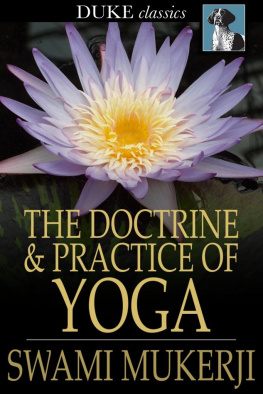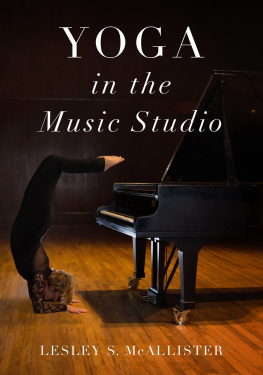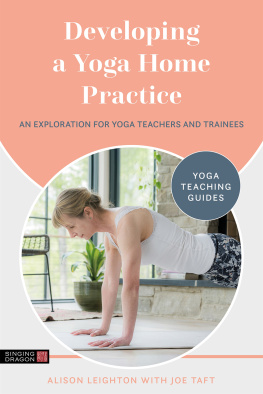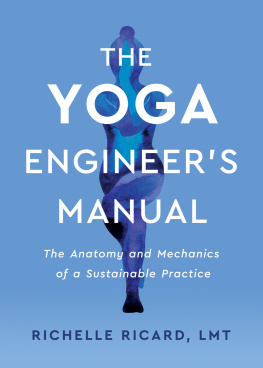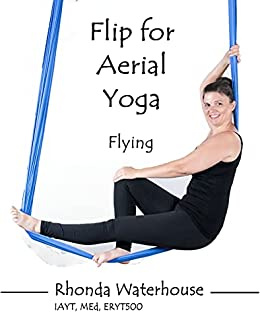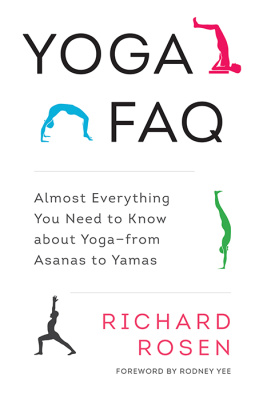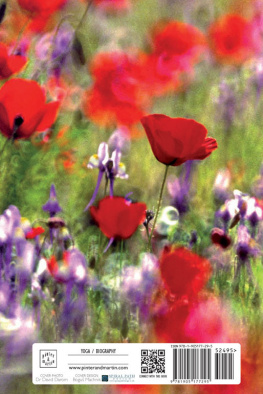Notes on Yoga
Notes on Yoga
The Legacy of Vanda Scaravelli
Diane Long and Sophy Hoare

Notes on Yoga: The Legacy of Vanda Scaravelli
First published by YogaWords, an imprint of Pinter & Martin Ltd 2016
2016 Diane Long and Sophy Hoare
Diane Long and Sophy Hoare have asserted their moral right to be identified as the author of this work in accordance with the Copyright, Designs and Patents Act of 1988.
All rights reserved
ISBN 978-1-906756-45-1
Also available as ebook
British Library Cataloguing-in-Publication Data
A catalogue record for this book is available from the British Library.
This book is sold subject to the condition that it shall not, by way of trade and otherwise, be lent, resold, hired out, or otherwise circulated without the publishers prior consent in any form or binding or cover other than that in which it is published and without a similar condition being imposed on the subsequent purchaser.
Set in Gill Sans and Optima
Printed and bound in the EU by Hussar Books
This book has been printed on paper that is sourced and harvested from sustainable forests and is FSC accredited.
Pinter & Martin Ltd
6 Effra Parade
London SW2 1PS
Notes on Yoga was edited and designed by Annette Heyer and Lise Bratton.
Cover designed by Annette Heyer, Lise Bratton and Rupert Wilks at Annettes Walmer Crescent Studio, Glasgow.
For Vanda, the guiding light shining throughout this book
Contents

Is it possible to have a different attitude in which a new intelligence, not imposed by authority but born from interest, attention and sensitivity, will emerge and in which body and mind, fused in one single action, are collaborating together? It is just this revolutionary attitude that we are going to discover through a new discipline in the practice of yoga.
Vanda Scaravelli
About this Book
V anda Scaravelli developed an approach to yoga that is radically different from most forms of yoga taught today. Her practice evolved over a period of forty years, during which time she accepted a small number of individual students, all of whom were teachers.
Diane Long was the first of her regular students and studied with her for twenty-three years. Sophy Hoare met Vanda during the period when she was writing Awakening the Spine, and worked with her intensively once or twice a year from then on.
Since the publication of her book, this form of yoga has spread throughout the world and Vanda Scaravelli is now well known.
The nature of the practice is subtle and, therefore, difficult to grasp. Vandas book inspires through its philosophy and images, but it does not go into detail when describing the practice of asanas. The teaching can be easily misinterpreted. Her approach to yoga was more revolutionary than many people realise, even those who attend Scaravelli classes.
In Notes on Yoga: The Legacy of Vanda Scaravelli, we have responded to requests from our students for a book that would help them with their practice. The result is this handbook, which consists of both suggestions and personal accounts of the experience of being taught by Vanda.
The structure of the book invites the reader to refer to different aspects of the text at different times. The photographs show playing at asanas and exploring within asanas. They depict sequences of movements through the body, not the held and accomplished poses.
Our approach throughout this book, as in our teaching, is to help students to let go of old assumptions about yoga. We are not attempting to explain how to do the yoga asanas; instead, we explore the asanas from a different perspective.
In ancient Indian philosophy, the ultimate, impersonal reality of the universe, Brahman, could be apprehended only by understanding what is not Brahman. This form of enquiry was known as neti, neti (literally not this, not this.) This yoga practice cannot be clearly prescribed or delineated, because the attempt to do so takes us further away from understanding. There is always more to discover than we already know.
When Vanda was teaching, she used a mixture of Sanskrit and English words for the asanas and, for the sake of ease and clarity, we are doing the same here. For example, we refer to Shoulder-stand rather than Salamba Sarvangasana, and Dog Pose rather than Urdhva Mukha Svanasana. But we refer to Virasana and Uttanasana because they are easy to say and widely used. Throughout, asana, pose and posture are interchangeable.

About Us
Sophy
W hen I worked with Vanda, I stayed in her house for a week or ten days at a time. Every morning she would summon me at about eleven oclock, when she had finished her own practice. Sometimes I had a lesson on my own and, sometimes, one of her weekly students would join us. When I was on my own, the practice was always intense and we worked hard and long. When other students were present it was instructive to watch how Vanda helped them with their practice. I noticed that she tended to go with their natural inclination; if they wanted to go slowly and take rests, she let them go at their own pace; if they had a more active rhythm, she would encourage it; if they wanted to focus on sitting and breathing, she readily acquiesced. This was in contrast to the teachers I had known at home who tried to wake up lazy students with vigorous poses, or calm down restless students with quieter ones. I began to understand the meaning of going with the body and not against it.

After a few years I met Diane at Vandas house and we shared some lessons. I had met her briefly once or twice in London and I was immediately struck by the change in her body since I had last seen her. I recognised the same quality of movement that Vanda had been demonstrating to me. This was the first time I had seen it so clearly in another person, and I was fascinated by it. If it was there in two people, then it must be possible for me to find it! Vanda was already eighty-three when I met her and every time I left her, I wondered if I would see her again. Since this practice turned out to be what my body had always been seeking, I asked Diane whether she would teach me and my students. That was the beginning of a long and fruitful collaboration. Because the practice constantly reveals surprises, I had the impression that Vanda, and Diane, could always surprise me. There has never been a moment of dullness. From our first meeting, I have continued to learn from Diane and I am honoured to have helped her write this book.
What appeals to me most about this approach to yoga is that it gives me the key to unlock my body and become freer than I have been before. There is a feeling of boundlessness and aliveness, calm energy that comes instantaneously. I recognise it as clean and true and right. It cuts through all personal preoccupations. I love its simplicity and its complexity, the fact that it can go on deepening and enriching itself for as long as I live. I love the fact that there are no rules, no authority outside the practice itself. I like the paradoxes contained within it and the poetic and philosophical reflections it can give rise to, if I have a mind to follow. And I like the fact that it is counter-cultural and questions our habits and assumptions, individually and collectively.


